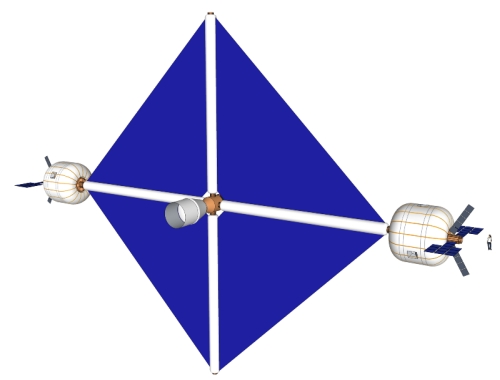On an 800 day space mission, astronauts would need 24 tons for six people for consumables (water, oxygen and food). McConnell and Alex Tolley have an idea is to deploy electric engines that use reclaimed water and waste gases to do the job.
Spacecoach enables us to begin building a space infrastructure that can extend past Mars to include the main asteroid belt. Using electric propulsion driven by a solar photovoltaic array, it achieves higher exhaust velocity than chemical rockets by a factor or ten, pulling much greater delta v from the same amount of propellant. Use water as propellant and you reduce the mass of the system by what McConnell estimates to be a factor of between 10 and 20.
The ships are propelled mostly by electric propulsion technology, and use water, carbon dioxide and gasified waste as propellant, essentially they convert the crew waste streams and reclaimed water into propellant after first pass use by the crew. Water and water rich material is used for other purposes, such as radiation shielding and heat management, while in passive storage.
Habitable areas are derived from inflatable structures, such as Bigelow Aerospace units, to allow large structures to be fit into existing launch systems and then be self-assembled in space with less manual intervention.
The ships are interplanetary vessels that never enter an atmosphere. They’re also completely reusable, allowing costs to be amortized, and their habitable areas are large inflatable structures that can be assembled in space. Thus we travel within a modular spacecraft using external landers and whatever other modules are required by the mission at hand.
They will also be able to fly many missions, with a useful life comparable to the ISS (20+ years) so their construction and initial launch cost can be amortized across 5 to 10 missions. Everything about the design is for reusability and multiple uses.
Rendering of the “kite” design pattern for a Spacecoach, with a person shown to the right for scale. This is but one possible configuration, but McConnell notes that the pattern minimizes the materials required even as it provides a sizeable habitable area. Credit: Rudiger Klaen.
Water as radiation shielding and propellant
The use of water and waste gases as propellant, besides reducing the mass of the system by a factor of ten or more, has enormous safety implications. 90% oxygen by mass, water can be used to generate oxygen via electrolysis, a simple process. By weight, it is comparable to lead as a radiation shielding material, so simply by placing water reservoirs around crew rest areas, the ship can reduce the crew’s radiation exposure several fold over the course of a mission. It is an excellent heat sink and can be used to regulate the temperature of the ship environment. The abundance of water also allows the life support system to be based on a one-pass or open loop design. Open loop systems will be much more reliable and basically maintenance free compared to a closed loop system such as what is used on the ISS. The abundance of water will also make the ships much more comfortable on a long journey.
McConnell calls the Spacecoach the basis of a ‘real world Starfleet,’ and adds this:
These ships will not be destination specific. They will be able to travel to destinations throughout the inner solar system, including cislunar space, Venus, Mars and with a large enough solar photovoltaic sail, to the Asteroid Belt and the dwarf planets Ceres and Vesta. They’ll be more like the Clipper ships of the past than the throwaway rocket + capsule design pattern we’ve all grown up with, and their component technologies can be upgraded with each outbound flight.
2015 book at Amazon – A Design for a Reusable Water-Based Spacecraft Known as the Spacecoach (SpringerBriefs in Space Development)
SOURCES- Centauri Dreams, Medium essay

Brian Wang is a Futurist Thought Leader and a popular Science blogger with 1 million readers per month. His blog Nextbigfuture.com is ranked #1 Science News Blog. It covers many disruptive technology and trends including Space, Robotics, Artificial Intelligence, Medicine, Anti-aging Biotechnology, and Nanotechnology.
Known for identifying cutting edge technologies, he is currently a Co-Founder of a startup and fundraiser for high potential early-stage companies. He is the Head of Research for Allocations for deep technology investments and an Angel Investor at Space Angels.
A frequent speaker at corporations, he has been a TEDx speaker, a Singularity University speaker and guest at numerous interviews for radio and podcasts. He is open to public speaking and advising engagements.


